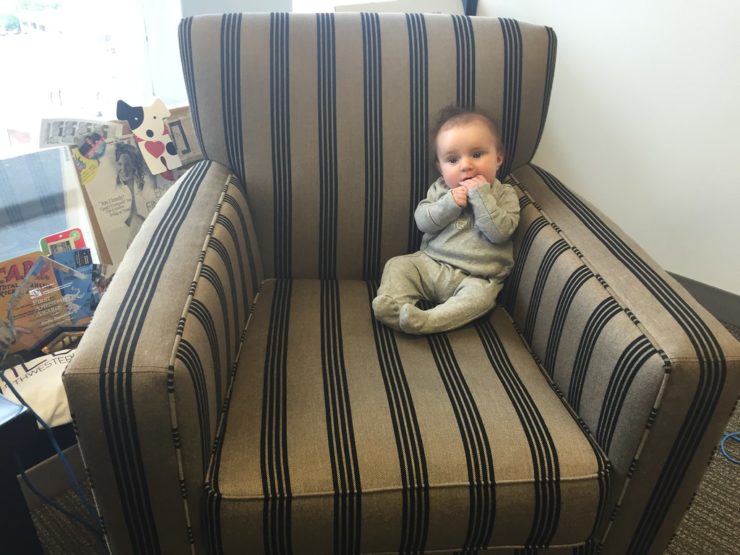A survey for Poynter on the family-friendliness of newsrooms found that nearly a third of respondents said their workplace was unsupportive of breastfeeding, which indicates the industry has work to do. In reporting “Where are the Mothers?,” I spoke with nearly 20 working moms in news about a wide range of experiences, and many of them described giving up on breastfeeding sooner than they’d initially planned because fitting pumping in between meetings, job duties, and childcare responsibilities was too challenging. Even in supportive environments, women often have to go to great lengths to fulfill their breastfeeding goals.
Continuing to breastfeed after you return to work in America often takes a serious commitment. Since there is no requirement for paid family leave, it’s very common for mothers who choose to breastfeed to be back at work before their baby is old enough to eat solid food. The American Academy of Pediatrics recommends that babies should be breastfed exclusively for about six months and should receive some breast milk for at least a year, which many mothers use as a benchmark recommendation when considering their breastfeeding plans.
In 2010, the Affordable Care Act put a number of legal provisions in place to protect working, nursing mothers, requiring some employers to provide space that’s not a bathroom and regular breaks to express milk. The U.S. Department of Health and Human Services made the case that employers providing breastfeeding support reduced doctor’s visits and health care costs. Additional research has shown that providing breastfeeding support improves employee retention, loyalty, and morale. However, workplace support and enforcement of existing laws can vary widely, and journalists can face additional logistical headaches if their jobs take them out of the office for reporting assignments.
Kate Sheppard, the enterprise editor at HuffPost’s D.C. bureau, wanted to continue breastfeeding for a year after her son was born in 2015 and had to go to significant lengths to reach that goal. While covering the 2016 election, she had incredibly awkward phone calls with the Democratic and Republican National committees about transporting her breast pump and breast milk into convention centers with very tight security. The RNC stipulated that “bottles of bodily fluids” were prohibited, and after many phone calls Sheppard finally got an answer that breast milk was not included in this prohibition. Neither convention provided a dedicated lactation room that she could find, so Sheppard used a single-stall bathroom at the Republican convention and her hotel room for the Democratic one because she couldn’t find a usable space.
But politics eventually got in the way of her breastfeeding efforts: “I basically just stopped pumping around the election because I was just too busy and I forgot. But at that point, I made it a year, and after being so tired from pumping and stressed about [milk] production, I was ready to set my pump on fire.”
When Emily Ramshaw, editor in chief of The Texas Tribune, returned to work in 2016, her daughter refused to take a bottle, despite every effort of her and her nanny. To navigate this challenge, Ramshaw got her caregiver a parking space and had the nanny bring her daughter to her multiple times a day, until she was 11 months old. “It was insane. There was basically a baby in the office all the time,” says Ramshaw.
Ramshaw described the office at the time as being full of mostly 20-somethings who didn’t have children. She put a curtain in front of her glass door and turned it into a de facto lactation suite. The experience had a profound impact on how she saw the difficulties for working mothers in news. “As the editor, I had an office with a locking door and the resources and flexibility to have a nanny bring the baby to me. It is not lost on me how few women in the workplace—and particularly the newsroom—have that luxury,” says Ramshaw.
Ramshaw often thought about how she would have managed if she hadn’t been the leader of her organization or had been out in the field reporting. Since Ramshaw’s daughter was born, a number of other women have had children at the Tribune, and Ramshaw is trying to make their pumping-at-work experiences easier. Office space is very tight, and although she is no longer nursing, her editor in chief office now doubles as the lactation suite for all the nursing mothers. She kept the curtains up and had a fridge put in and vacates her office when women need to pump, even occasionally holding important meetings in the hall so they can have privacy.
If you believe that women should be fully supported in making their own breastfeeding choices, having more people in authority who are empathetic to the challenges of being a nursing mother can go a long way toward providing needed resources and creating a supportive culture.
For more information on the rights of pregnant and nursing mothers, check out A Better Balance’s state-by-state resource guide. Womenshealth.gov has excellent research and data on the business case for employers to support breastfeeding. And transforming an office pumping room from legally compliant to “best in class” doesn't take much effort; check out this Washington Post article on what an ideal lactation room looks like, and why.




